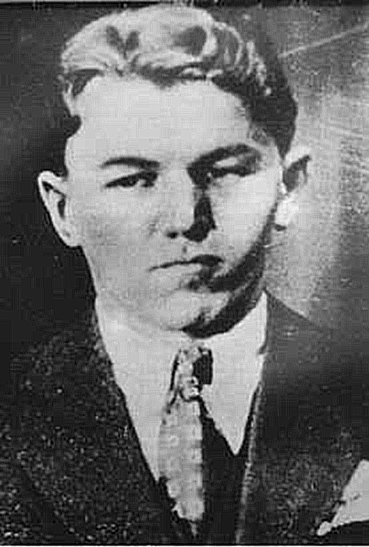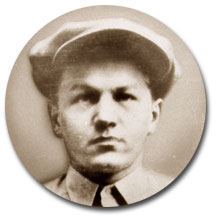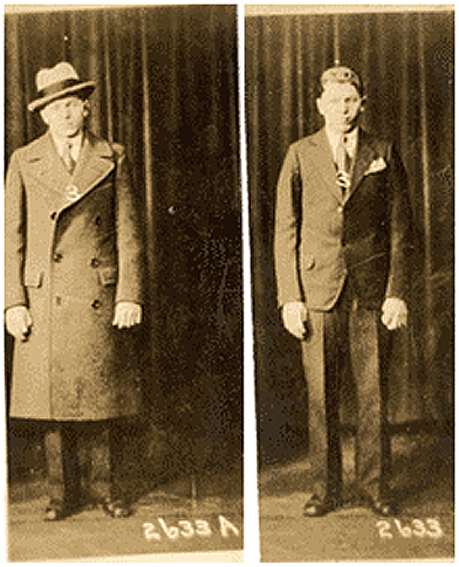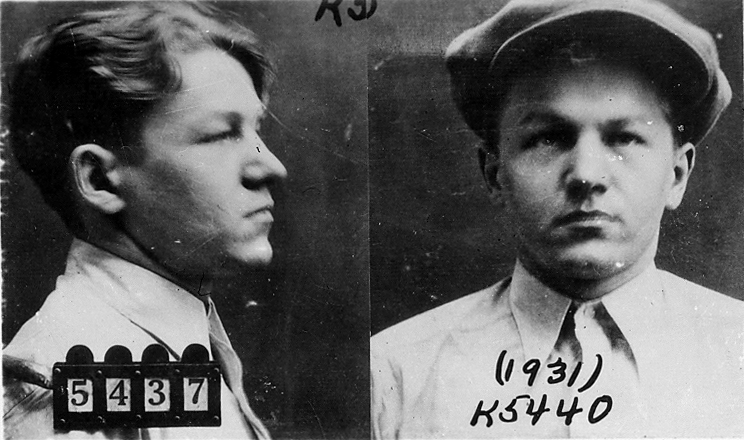When people like John Dillinger and Alvin Karpis think you are too ruthless and reckless, you know you might have a screw loose or two. George Nelson was the perfect embodiment of the phrase “looks can be deceiving.” His small stature and boyish features suggested a respectable, even innocent young man, hence his nickname “Baby Face.” That, however, could not have been further from the truth. Behind that youthful appearance hid a cold and calculated killer, one who knew of only one way of dealing with his problems – violence.
One true crime writer pointed out the key difference between Nelson and his confederates from the Public Enemy era. While many had no qualms about killing, most of the others only did it in order to protect themselves or escape. Baby Face Nelson, on the other hand, “went out of his way to murder” because he liked it. He was a psychopath who had found the perfect career.

Early Years
Baby Face Nelson was born Lester Joseph Gillis on December 6, 1908, in the Near West Side neighborhood of Chicago, the youngest of seven children to Joseph Gillis and Marie Doguet. His parents were both Belgian immigrants who grew up together in the same city of Leuven. They left for America separately and found each other again in Chicago and decided to get hitched a few months later. Joseph Gillis was an industrious, skilled tanner who made enough money to build his family a three-story redbrick house near Humboldt Park. Meanwhile, Marie was a former schoolteacher who hoped to further her education in America, maybe even resume teaching, but had to give up those ambitions in order to look after her ever-growing family. Both parents worked hard to provide their children with a good upbringing and instill in them the traits of integrity, honesty, and diligence. In most cases, it worked, but not for little Lester, who began straying from the straight and narrow path from an early age.
It started in his pre-teen years when puberty swept through the neighborhood. All the other boys shot up like weeds, but Lester reached 5ft 4 and his body said “That’s enough for you!” His small size, plus his eponymous “baby face” made him an easy target for bullies, so Lester was picked on regularly until he decided to fight back. At 12 years old, he already had a Napoleon complex and overcompensated for his short stature with ruthless aggression. It didn’t matter how old or big the other kid was, Lester never backed down from a confrontation and he didn’t shy away from fighting dirty, either. As long as the other kid was down and he was still standing, that’s all that mattered.
In a short while, Lester Gillis developed a reputation as the toughest kid in the neighborhood and he began hanging out with like-minded individuals or, in other words, a gang of juvenile delinquents called the Halsted Street Boys.
School became almost a non-factor in Lester’s life. He was expelled several times for truancy, and the story repeated itself each time he was enrolled at a new school. His parents knew they had a troubled child on their hands, but they kept convincing themselves that his actions were the result of an overenergetic personality or simply boyhood pranks.
This changed in 1922 when 13-year-old Lester was arrested for car theft and sentenced to 18 months inside the Illinois State School for Boys in St. Charles. At first, he hated it there, which was hardly surprising, but things started getting better once Lester was transferred to work in the machine shop. He discovered that not only was he good at it, but he enjoyed working with machinery to the point where he began volunteering to do extra jobs in order to help out other students. He also performed well during military drills, and while his school work wasn’t exactly “honor roll” material, he did enough to get by. By the time Lester was due to leave, he actually agreed to stay on an extra month so that he could graduate the 8th grade and get his diploma.
Once he got back home, his mother desperately hoped that Lester’s time inside the reformatory school genuinely changed him. Whether he wanted to find a job or continue his studies, she was ok with either one, as long as he stayed out of trouble.
But alas, we know that neither of those came to be. Soon after returning home, Lester started hanging out with some of his old friends again. One summer day, they got caught taking a joyride in a stolen car and Lester was sent back to the reformatory school. During his second stint in juvie, a combination of alcoholism, depression, and financial woes drove Joseph Gillis to suicide.
Racked with guilt over his father’s death, Lester tried to go straight again when he was released and even found a job as an assistant mechanic. But it was the same old story. The honest life simply didn’t stick to Lester and the promise of easy money steered him towards a life of crime again, this time with no turning back.
Baby Face Nelson
Despite Lester’s attraction to motoring malfeasance, he was certainly no criminal mastermind. Almost exactly one year after being released from St. Charles, Gillis was arrested while stealing another car and was sent to the reformatory school for the third and final time. He was over 18 when he got out so, from then on, if he got popped, he risked jail time.
This didn’t deter Lester, however. He kept hanging out in the same shady places, with the same shady people, so it was only a matter of time before he turned shady, as well. Lester started out small by joining a “tire-theft ring” with a few neighborhood buddies, but he got pinched almost immediately during a burglary. He only got probation thanks to some heavy pleading from his mother. As before, the arrest was followed by a brief law-abiding period, but this one was notable because Gillis met and married a teenage salesgirl named Helen Wawrzyniak.
Once the “honeymoon period” was over, Gillis got back to business with a spot of bootlegging since that was the big moneymaker of that time. Some reports claimed Lester ran with an Irish mob called the Touhy Gang for a while, although this relationship was short-lived and frivolous. This was probably better for Gillis since the Touhy Gang soon ran afoul of Al Capone who was in the midst of his ascent to the top of the criminal world and wanted to exert a stranglehold on Chicago’s bootlegging industry.

Speaking of Capone, his association with Gillis is probably the most uncertain aspect of the latter’s life, to the point where we’re not even sure if there was one. Some sources claim there was a small window where Gillis worked for Capone under his capo Jack McGurn. The job mainly involved getting labor unions to fall in line, but Lester got kicked out because he was too gung-ho when it came to dishing out corporal punishment. Some even say that Gillis killed his first man during this period but, as we mentioned, we can’t guarantee any of this ever happened.
Two things we can say for certain, though. One – this was around the time that Gillis advanced from bootlegging and car theft to more violent crimes. And two – Lester wasn’t Lester, anymore. He started going by George Nelson. We can’t really say why, maybe he simply thought it sounded cooler. We can say that, despite the name change, he still got stuck with the nickname he absolutely hated and the one by which he is remembered even today – Baby Face Nelson.
Diamonds and Dollars
Even if Nelson was involved with the mob, it was a short-lived arrangement. He preferred to operate with a small group of like-minded outlaws who all shared the same goal – making money. That being said, there was nothing to gain from making enemies of the mob, so Nelson stayed away from bootlegging and other rackets Capone might have an interest in. Instead, he decided to become a jewelry thief. With the onset of the Great Depression, banks were closing and businesses were failing left and right. Nelson concluded that rich people would store their money in things that wouldn’t lose their value…such as jewels, for instance. Therefore, any big, fancy house in the swanky part of Chicago was likely to have a lot of bling ripe for the taking.
Baby Face Nelson put his idea to the test on January 6, 1930. His target was 1418 Lake Shore Drive – the mansion of Consolidation Magazine Corporation Vice President Charles Richter. That night, Nelson and four cohorts forced their way into the Richter household armed with pistols and shotguns and quickly gained control of the mansion’s occupants. The Richters cooperated, gave up their valuables, and the robbers were out the door in 20 minutes, carrying about $25,000 in plunder. Nelson almost couldn’t believe how easy it was. While others struggled to put food on the table, just a few minutes of work made him more money than the average American made in a year. From that point on, never again would he attempt to go straight. The life of the working stiff was for suckers.
Just a couple of weeks later, the gang pulled off another heist. This time, they targeted the house of a wealthy attorney. Just the maids were home, which made the job even easier. They only got $5,000 worth of valuables, but still a decent haul for one night’s work.
Both heists paled in comparison to Nelson’s third robbery in March 1930, when he raided the Van Buelow mansion of $70,000 worth of jewelry and cash. And there were only three robbers this time, so each share was even bigger.
Three quick robberies, in and out, netting $100,000, which is about $1.6 million in today’s money. But that was what the loot was worth, it wasn’t anywhere near what the thieves could get for it. By the time of the third heist, Chicago was up in arms about this new criminal ring, which was targeting the city’s rich and powerful. The stolen jewels were as hot as Hades on a summer Sunday, so most fences either didn’t want to touch them or only offered pennies on the dollar. Therefore, Baby Face Nelson unceremoniously brought an end to his career as a jewel thief and decided to deal strictly with paper currency from then on.
His first “transaction” occurred on October 3, 1930, when he and his two pals robbed the State Bank of Itasca in Du Page County, making off with over $4,600 in cold, hard cash. Next up was the bank in Plainfield, Illinois, but the criminals had to leave empty-handed as the bank manager smiled at them smugly behind bulletproof glass. Their third stick-up, however, at the Hillside State Bank, went much smoother and resulted in about the same amount of money as their first bank heist.
Soon enough, the police realized that these robberies were all being committed by the same gang. After all, the criminals didn’t really make an effort to hide their identities, and there was one person that stood out to all the witnesses – a short guy with blond hair and deep, blue eyes, and the cherubic look of an innocent youngster. An anonymous tip from the Chicago underworld even got the police a name – George Nelson, often called “Baby Face” and “Big George” behind his back.

Rounding up the suspects wasn’t exactly the work of Kojak. As we said, the crew didn’t cover their tracks too well. By February 1931, Nelson and his two main accomplices were in custody, all taken in without a fight. They had been identified by a few dozen witnesses so the case against them was as solid as granite and the police chief was cheerfully touting the arrest of the stick-up trio as “among the most important in the police history of Chicago.” One of his subordinates even included the “Baby Face” name in the official press release for the media, thus ensuring that Nelson would forever be immortalized by the moniker he hated most.
The trial went about as well as you’d expect. One of the three robbers testified against the other two in exchange for probation. The other pled guilty for a reduced sentence. Only Nelson refused to deal. He insisted that he was innocent, but the jury wasn’t taken in by his boyish charm. They took less than two hours to find him guilty. Nelson was then sentenced to one year to life in the state prison at Joliet.
Hitting the Big Time
Nelson spent less than one year in prison. In February 1932, he was due to stand trial for a solo robbery but, for some reason, the authorities concluded that a single burly prison guard would be enough to keep an eye on the diminutive delinquent. The duo was riding the train back to Joliet when Nelson managed to get his hands on a .45 automatic, most likely hidden by an accomplice. Baby Face took the guard and a taxi driver hostage and drove to the middle of nowhere. That’s when he told them to get out and rode off alone into the sunset.
With the law on his tail, Nelson fled Illinois and made his way to Reno, Nevada. He didn’t spend a lot of time there, but enough for him to pal around with some other prominent outlaws of that era, such as Alvin Karpis, who ran with the Barker Gang, and Eddie Bentz, a confederate of “Machine Gun” Kelly. They pulled off several heists together, this time traveling from state to state instead of staying in the same place and making it as far north as Minnesota. However, it was in Sausalito, California, that Nelson made the acquaintance of John Paul Chase, the man who would become his new partner-in-crime ‘til the bitter end.
After pulling a few scores with more experienced bank robbers like Karpis and Bentz, Nelson gained the confidence to start his own crew. Chase was his right-hand man, and other members included Eddie Green, Tommy Carroll, and Homer Van Meter. Together, they executed a string of robberies all across the country. Most notorious was the one in Brainerd, Minnesota. Feeling cocky following a textbook bank heist, the gang wanted to leave guns blazing…literally. Nelson and Van Meter stuck their Tommy guns out the windows of their getaway car as they sped out of town and sprayed both sides of the street with bullets. They smashed dozens of store and car windows but, through some miracle, they didn’t hit a single person. Not that fatalities would have bothered them too much. The gang soon claimed their first-known victim in a gunfight with San Antonio police, where Detective Henry Perrow was shot and killed. As to the triggerman, witnesses claimed Tommy Carroll was the killer, but he was never positively ID’d.
That is, pretty much, how Nelson and his gang spent 1933. Although George’s wife never participated in any robberies, she accepted that this was who he was, and often followed him around with the kids, so the family could spend time together whenever Nelson was laying low.
It was also during this time that Nelson met another leading light of the underworld, someone that Van Meter did time with back in Indiana – John Dillinger. The two gangs met up at a safe house in Chicago. Their little gathering was cordial enough. They swapped adventures, they exchanged useful contacts, and they drank. All except Nelson – he never touched alcohol after what it did to his father. And that was about it…at least, for the time being.
The Dillinger (and Nelson) Gang
Now then, if you have seen our Biographics video on John Dillinger, then you would know that the Dillinger Gang had two distinct incarnations. In January 1934, the first crew was captured in Tucson, Arizona, and all the original members found themselves in prison except for one guy named Red Hamilton. Like Dillinger, Hamilton was on good terms with Van Meter, and with nowhere else to turn to, he joined up with Nelson’s gang. After all, as far as he knew, none of his former compatriots would see life outside the prison walls ever again, with some of them even scoring a date with the electric chair.
But John Dillinger escaped prison in early March, perhaps even with Hamilton’s help, and was itching to stick up a few banks. The old gang was gone, but Hamilton had already hooked up with a new crew. The only question was – could Dillinger and Nelson get along? Here you had two guys who both wanted to be the leader, one of them with a serious overcompensation problem. They had what you would call a “clash of personalities” and Nelson was none too pleased whenever other gang members would turn to Dillinger instead of him since he liked to think that he was still the one in charge. He probably blew a gasket when he saw the newspapers referring to the group as the Dillinger Gang and he reacted, predictably, with violence.
It was at this time that Baby Face Nelson fully embraced his dark side and turned into the most ruthless man in the country. Even before pulling off their first heist, Nelson killed a paint salesman from Minnesota named Ted Kidder, gunning him down in front of a diner while his wife and mother-in-law watched. Why exactly he did this nobody is sure to this day…Then, when the gang did commit their first robbery together – the Security National Bank in Sioux Falls, South Dakota – Nelson let loose with his Tommy gun on a motorcycle patrolman named Hale Keith, and, as the officer collapsed to the ground, he proudly shouted: “I got one, I got one.”
With all the bodies they kept dropping came increased heat from the police, not to mention that the FBI got involved, as well. Shootouts between the two sides became more frequent and more violent, ultimately making it clear that there was only one way this would end.
Hail of Bullets
Eddie Green was the first to go following a shootout with the FBI at his hideout in St. Paul, Minnesota, in early April. A couple of weeks later, the rest of the gang and their wives/girlfriends were laying low at the Little Bohemia Lodge in Wisconsin. Someone tipped off the feds about their presence, which led to a botched raid that turned into a bloodbath. The lawmen opened fire on a group of innocent bystanders in a case of mistaken identity, killing a man named Eugene Boisneau.
The gunshots tipped off Dillinger and the gang who returned fire and managed to make it to their cars and escape, leaving the women behind. Meanwhile, Nelson was the only one who wasn’t with the group when the shooting started, so he had to make it on his own. He ran through the woods for a while before stealing a vehicle and then driving to a remote house where he took everyone hostage. Unbeknownst to him, however, the people inside called the authorities as soon as they saw the vehicle pull up in front of their home. A police car arrived on the scene with two FBI agents and a local constable and Nelson gleefully opened fire on them all. Two of them were seriously wounded while Special Agent W. Carter Baum was hit in the neck and died in minutes. Nelson then got into their car and drove away.
After the shootout at Little Bohemia, the gang went their separate ways. Maybe they planned on reuniting later, who knows, but they never got the chance because they started dropping like flies. Hamilton died in another gunfight just a few days later. Then, over the summer, Tommy Carroll, Homer Van Meter, and even Dillinger himself all bit the big one following shootouts with law enforcement. All of a sudden, it was just Nelson, his wife, Helen Gillis, and John Paul Chase. Finally, Baby Face Nelson got to enjoy the notoriety of being Public Enemy No.1.
For a short while, at least. Nelson wisely decided to keep a low profile and stay on the move, but that is easier said than done when you’re the most wanted man in the country. He had a close call in late November, in Lake Geneva, Wisconsin, when he ran into some feds staking out a former hideout of his, but managed to get away, uncharacteristically, without firing a single shot.
But even so, the noose was tightening around Nelson’s neck. The FBI now had his car, his number plates, and were hot on his tail. They caught up to him on November 27, 1934, in the town of Barrington, Illinois, and staged one final shootout that wouldn’t feel out of place in any action movie. We had three cars, one filled with criminals, two with FBI agents, racing on the highway side by side. Nelson drove while Chase took out one car with a few well-placed shots, but their own vehicle took a bullet to the radiator that left them partially disabled. Minutes later, their ride conked out, so Nelson veered off the highway into a park in Barrington. The second FBI car with agents Samuel Cowley and Herman Hollis pulled up close to it, but was immediately met with a spray of bullets from Nelson and Chase. The lawmen returned fire, but the crooks had the upper hand. Hollis was shot and killed during the battle, while Cowley was mortally injured. Nelson and his accomplices got in the FBI car and drove away, seemingly triumphant once again.

But that was not the case this time. Chase and Helen Gillis might have escaped unscathed, but the same could not be said for Nelson who had sustained several gunshot wounds. Just a few hours later, Baby Face Nelson was dead. His body was found the next day left in a cemetery in a nearby town.
Both Helen Gillis and John Paul Chase were arrested soon after. She served one year in prison for harboring a known criminal, while Chase spent 32 years behind bars before being released on parole in 1966. As for Baby Face Nelson, he liked to brag that he would never be taken alive. He got his wish – a bloody but unsurprising end for one of the most ruthless criminals in American history.



